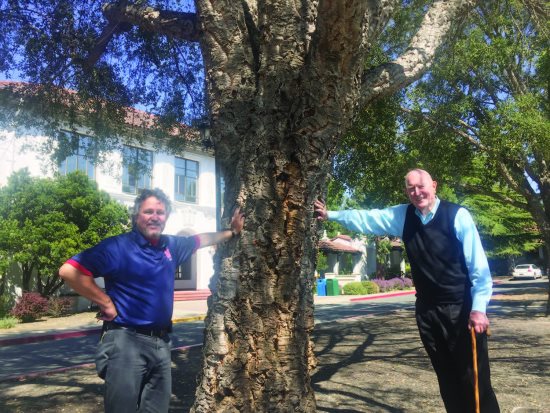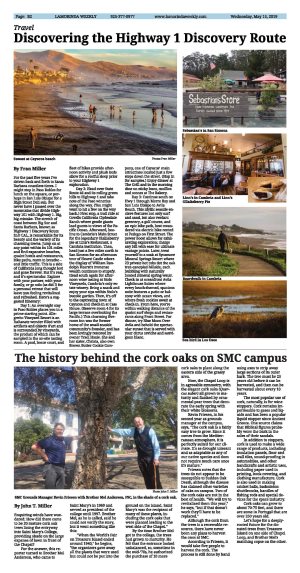| | Published May 15th, 2019
| The history behind the cork oaks on SMC campus
| | | By John T. Miller |  | | SMC Grounds Manager Kevin Friesen with Brother Mel Anderson, FSC, in the shade of a cork oak. Photo John T. Miller |
Enquiring minds have wondered: How did there come to be 20 mature cork oak trees lining the entryway into Saint Mary's College, providing shade on the large expanse of lawn in front of the Chapel?
 For the answer, this reporter turned to Brother Mel Anderson, who came to Saint Mary's in 1969 and served as president of the college until 1997. Brother Mel, as he is called, said he could not verify the story, but it went something like this:
For the answer, this reporter turned to Brother Mel Anderson, who came to Saint Mary's in 1969 and served as president of the college until 1997. Brother Mel, as he is called, said he could not verify the story, but it went something like this:
 "When the World's Fair on Treasure Island ended around 1940," he begins, "the organizers gave away all the plants that were used but could not be put into the ground on the island. Saint Mary's was the recipient of many of these plants, including the cork oaks that were planted leading to the west side of the Chapel."
"When the World's Fair on Treasure Island ended around 1940," he begins, "the organizers gave away all the plants that were used but could not be put into the ground on the island. Saint Mary's was the recipient of many of these plants, including the cork oaks that were planted leading to the west side of the Chapel."
 By the time Brother Mel got to the college, the trees had grown to maturity. He felt that the entrance looked unbalanced, so, sometime in the mid-`70s, he authorized the purchase of 10 more cork oaks to plant along the eastern side of the grassy area.
By the time Brother Mel got to the college, the trees had grown to maturity. He felt that the entrance looked unbalanced, so, sometime in the mid-`70s, he authorized the purchase of 10 more cork oaks to plant along the eastern side of the grassy area.
 Now, the Chapel Loop is in agreeable symmetry, with the elegant cork oaks (Quercus suber) all grown to maturity and flanked by ornamental pear trees that decorate the early spring with their white blossoms.
Now, the Chapel Loop is in agreeable symmetry, with the elegant cork oaks (Quercus suber) all grown to maturity and flanked by ornamental pear trees that decorate the early spring with their white blossoms.
 Kevin Friesen, in his second year as grounds manager at the campus, says, "The cork oak is a fairly easy tree to grow. Since it comes from the Mediterranean atmosphere, it is perfectly suited for our climate. It's as drought tolerant and as adaptable as any of our native species and does not require much care once it's mature."
Kevin Friesen, in his second year as grounds manager at the campus, says, "The cork oak is a fairly easy tree to grow. Since it comes from the Mediterranean atmosphere, it is perfectly suited for our climate. It's as drought tolerant and as adaptable as any of our native species and does not require much care once it's mature."
 Friesen notes that the trees do not appear to be susceptible to Sudden Oak Death, although the disease has claimed other varieties of oaks on campus. Two of the cork oaks are not in the best of health. "We will try to revitalized them this year," he says, "but if that doesn't work they'll have to be replaced."
Friesen notes that the trees do not appear to be susceptible to Sudden Oak Death, although the disease has claimed other varieties of oaks on campus. Two of the cork oaks are not in the best of health. "We will try to revitalized them this year," he says, "but if that doesn't work they'll have to be replaced."
 Although the cork from the trees is a renewable resource, there have never been any plans to harvest the ones at SMC.
Although the cork from the trees is a renewable resource, there have never been any plans to harvest the ones at SMC.
 According to Friesen, it would take five people to harvest the cork. The process is still done by hand using axes to strip away large sections of its outer bark. The tree must be 25 years old before it can be harvested, and then can be harvested about every 10 years.
According to Friesen, it would take five people to harvest the cork. The process is still done by hand using axes to strip away large sections of its outer bark. The tree must be 25 years old before it can be harvested, and then can be harvested about every 10 years.
 The most popular use of cork, naturally, is for wine stoppers. Cork remains impermeable to gases and liquids and has been a popular liquid stopper since Ancient Greece. One source claims that Biblical figures probably wore the bark in the soles of their sandals.
The most popular use of cork, naturally, is for wine stoppers. Cork remains impermeable to gases and liquids and has been a popular liquid stopper since Ancient Greece. One source claims that Biblical figures probably wore the bark in the soles of their sandals.
 In addition to stoppers, cork is used to make a wide range of products, including insulation panels, floor and wall tiles, sound-proofing in automobiles, and other handicrafts and artistic uses, including paper used in printing, book covering, and clothing manufacture. Cork is also used in making cricket balls, badminton shuttlecocks, handles of fishing rods and special devices for the space industry.
In addition to stoppers, cork is used to make a wide range of products, including insulation panels, floor and wall tiles, sound-proofing in automobiles, and other handicrafts and artistic uses, including paper used in printing, book covering, and clothing manufacture. Cork is also used in making cricket balls, badminton shuttlecocks, handles of fishing rods and special devices for the space industry.
 Cork oaks can grow to about 70-75 feet, and there are some in Portugal that are over 250 years old.
Cork oaks can grow to about 70-75 feet, and there are some in Portugal that are over 250 years old.
 Let's hope for a deeply-rooted future for the donated trees from Treasure Island on one side of Chapel Loop, and Brother Mel's matching copse on the other.
Let's hope for a deeply-rooted future for the donated trees from Treasure Island on one side of Chapel Loop, and Brother Mel's matching copse on the other. |
| | | | | | | | | | | | |



